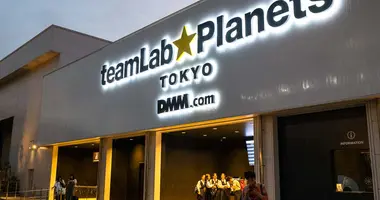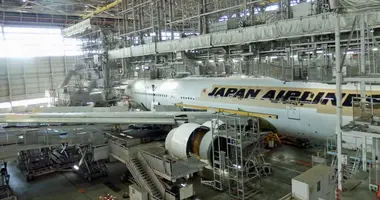Sewerage Museum
The Sewerage Museum in Takanodai, Kodaira City, Tokyo has displays on Tokyo's sewerage system from Edo times to the present day.
Sewerage Museum, Takanodai, Kodaira City, Tokyo ふれあい下水道館,鷹の台,小平,東京
by Johannes Schonherr
Japanese manhole covers often come in color and they always feature imagery the issuing city considers remarkable sources of local pride. Images of historical events, images of famous products, images of the local landscape. Pretty much anything goes.
Spotting and photographing manhole covers has become a popular pastime, many visitors take a shot of the various manhole covers they encounter on their travels in Japan.

Manhole Cover, Kodaira City, Tokyo
But what exactly is below those manhole covers? Sure, somewhere down there is a system of pipes that collect and transport all used water and direct it to facilities that clean it up again. But how exactly does that work?
At the Sewerage Museum (Fureai Gesuidokan in Japanese), the city of Kodaira, a suburb in the west of Tokyo, tries to give a thorough answer to such questions, topping it off with the experience of a visit to an actual underground sewerage canal.
 Sewerage Museum, Takanodai, Kodaira City, Tokyo
Sewerage Museum, Takanodai, Kodaira City, Tokyo Tamagawa Josui Canal, Takanodai, Kodaira City, Tokyo
Tamagawa Josui Canal, Takanodai, Kodaira City, Tokyo
Tamagawa Josui Canal
Walking from Takanodai train station to the Sewerage Museum, you will stroll for about 500 meters along a short stretch of a very historic waterworks, the Tamagawa Josui Canal.
This canal was built by the Tokugawa shogunate in 1653 to supply Edo, the old Tokyo, with drinking water as well as a water source to fight fires. 43 kilometers long in total, the Tamagawa Josui Canal diverted fresh water from the Tama River and brought it right to inner city Edo.
This part of the old canal in Takanodai is embedded in a narrow strip of forest, with pedestrian walkways on both sides of the canal.

Tamagawa Josui Canal in Edo Times, Wood Block Print at the Sewerage Museum, Kodaira, Tokyo Man on the Toilet, Sewerage Museum, Kodaira City, Tokyo
Man on the Toilet, Sewerage Museum, Kodaira City, Tokyo
The Sewerage Museum
The Sewerage Museum, also known in English as the Kodaira Sewerage Center, is located very close to the Tamagawa Josui Canal. No doubt, the nearby historic water supply route played an important role in the conception of this quirky Tokyo museum.
Just that the museum, opened in 1995, went the opposite way: instead of the water supply, it focuses on the disposal (and cleaning) of used water.
Arriving at the museum, you first see a big door in the museum's wall fronting the street. That's not the entrance. It's a public toilet, hinting at what awaits the visitor inside the facility.
The museum entrance is to the left of the building. A small artificial freshwater stream flows along that side of the building, signaling the theme of the museum.
Admission is free. At the service counter, every visitor receives a museum guide pamphlet and a little brochure which in comic book style explains the basic features of waste water treatment. Including information on what and what not to put down the drain (no oil into the waste water!)
 Waste water pipes on display, Sewerage Museum, Kodaira, Tokyo
Waste water pipes on display, Sewerage Museum, Kodaira, Tokyo
The Exhibits
The museum reaches 5 floors down into the ground. The B1 Floor houses a seminar room. The exhibits start at the B2 Floor - with the perhaps best known exhibit of the site: the sculpture of a man sitting on a toilet, reading a newspaper.
In fact, the sculpture is part of a group giving examples of typical water use but you wouldn't be the first to overlook the other, less impressive sculptures.
The B2 Floor gives a time line of the development of waste water treatment in Tokyo, and Kodaira in particular, from the Edo Period to the present day. This is also the floor where the basics of waste water treatment are explained.
The B3 Floor focuses particularly on the situation in Kodaira, both historical and current. A large blow-up of an ukiyo-e wood block print features Mount Fuji behind the blossoming cherry trees along the Kodaira section of the Tamagawa Josui Canal in Edo times.
Plenty of drawings and photos are on display, including pictures of flooded, broken drainage tunnels after earthquakes and heavy typhoons.
The B4 Floor is the Special Exhibition Floor. Changing exhibitions are on display here, often focusing on historical aspects of the Tokyo waterworks.
At about 22 meters below the surface you reach the B5 Floor, labeled the Fureai Experience Room. It leads straight to the Experience Corner. There, you are able to step on a bridge spanning an actual, working wastewater tunnel.
It's a giant concrete tunnel. A sort of brown soup flows in a constant stream on the bottom of the tunnel, sometimes carrying little objects of an unidentifiable nature with it. Waste water right out of the sewers, kitchen sinks and toilets of Kodaira City, heading for a distant cleaning facility.
It smells, of course, but not as intensely as one might expect. The tunnel is well ventilated.
Note: All information provided by the museum, the pamphlets as well as all explanations on the exhibits, are only in Japanese. There are however plenty of visual materials on display, making a visit worthwhile for non-Japanese speakers as well.
 View into a real sewerage tunnel, Sewerage Museum, Kodaira, Tokyo
View into a real sewerage tunnel, Sewerage Museum, Kodaira, Tokyo
Access
Seibu Shinjuku Line to Higashi Murayama Station, change to the Seibu Kokubunji Line for the direction Kokubunji, get off at Takanodai Station.
JR Chuo Line to Kokubunji, change to the Seibu Kokubunji Line for the direction Higashi Murayama, get off at Takanodai Station.
Opening times
Tuesday to Sunday 10 am to 4 pm. If Monday is a holiday, the museum will close the next day.
Closed over New Year's from December 27th to January 5th.
Admission
Admission is free.
Address
1-25-31 Josui Honcho, Kodaira City, Tokyo
Tel: 042 326 7411
Website www.city.kodaira.tokyo.jp (in Japanese)
The Sewerage Museum on Google maps
Related Articles
Kasukabe Underground Flood Protection Tank
Tokyo Water Science Museum
Tokyo Waterworks Historical Museum
Toto Toilet Museum
Kodaira Furusato Mura





























